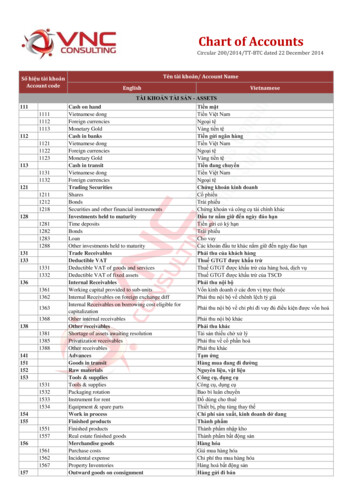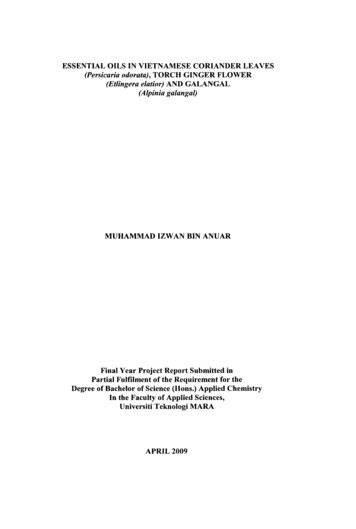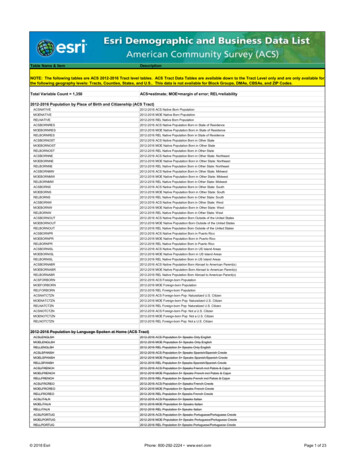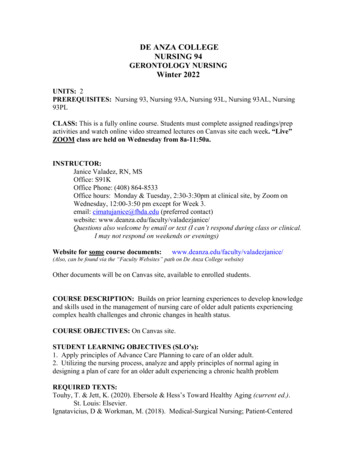
Transcription
Department of Public Health and Caring ScienceVietnamese nursing students' knowledge in Cardiopulmonaryresuscitation (CPR) and perceptions of training in CPRAuthors:Supervisor:Emelie KihlbergLeif ErikssonNadine RosenkvistExaminer: Mariann HedströmThesis Work of Health Science 15 hpNursing Program, 180 HP2018
ABSTRACTBackgroundCardiopulmonary resuscitation (CPR) increases significantly the chance of survival in casesof a cardiac arrest. The ability to respond quickly and effectively to a cardiac arrest rests onnurses being competent, prepared and up-to-date. Nursing student’s knowledge in CPR andperceptions of their own training are crucial for the pursuit of the education of professionalnurses.AimInvestigate the prerequisites for a good care of patients in need of CPR by assessingVietnamese nursing students' knowledge in CPR as well as their perceptions on theireducation in CPR.MethodA quantitative, cross sectional-study was conducted. A modified version of a questionnairedeveloped by the Swedish council of CPR was used. Nursing students at University ofMedicine and Pharmacy in Ho Chi Minh City were asked to participate. The gathered datawere analyzed with descriptive statistics, t-test and chi2 -test.ResultThe participants answered right on 41 % of the questions (571/1404). The mean-score was5.25 and the score ranged from 0 to 9 out of 13 points on the questionnaire. Participantsanswered correctly on most questions regarding basic CPR and were foremost wrong aboutquestions regarding defibrillation. There was no association between a high result on thequestionnaire and students rating a high grading on preparedness and/or satisfaction. Nosignificant difference could be found based on gender.ConclusionThe knowledge in CPR, based on this survey, is generally low. One plausible explanationcould be that the questionnaire did not fit the education of the participants.Keywords: Cardiopulmonary resuscitation, cardiac arrest, education, nursing students.
SAMMANFATTNINGBakgrundHjärt- och lungräddning (HLR) ökar avsevärt chanserna att överleva vid ett hjärtstopp. Attkunna reagera snabbt och effektivt på hjärtstillestånd kräver att sjuksköterskor är kompetentaoch förberedda. Sjuksköterskestudenters kunskaper i HLR och deras uppfattningar om sinutbildning är avgörande för den fortsatta utbildningen av professionella sjuksköterskor.SyfteUndersöka förutsättningarna för en patientsäker vård inom HLR, genom att kartläggavietnamesiska sjuksköterskestudenters kunskaper i HLR samt att undersöka deras uppfattningom sin utbildning i HLR.MetodEn kvantitativ, tvärsnittsstudie genomfördes. En modifierad version av ett frågeformulärutvecklat av Svenska rådet för hjärt- och lungräddning (HLR-rådet) användes.Sjuksköterskestudenter i en klass från University of Medicine and Pharmacy, i Ho Chi MinhCity blev ombedda att delta. Den insamlade informationen analyserades med beskrivandestatistik, t-test och chi2-test.ResultatDeltagarna svarade rätt på 41% av frågorna (571/1404). Det totala medelvärdet var 5.25 ochpoängen skilde sig från 0 till 9 av 13 poäng på frågeformuläret. Deltagarna svarade korrekt påde flesta frågor angående grundläggande HLR och svarade främst fel på frågor angåendedefibrillering. Det fanns inget samband mellan ett högt resultat på frågeformuläret och eleversom ansåg sig vara förberedda och/eller nöjda med sin utbildning. Ingen signifikant skillnad iresultat kunde hittas baserat på kön.SlutsatsKunskaperna i HLR, baserat på den genomförda studien, är generellt låga. När det kommertill vissa frågor kan en orsak vara att frågeformuläret inte var anpassat efter deltagarnasutbildning.Nyckelord: Hjärt- och lungräddning, hjärtstopp, utbildning, sjuksköterskestudent.
INDEXBACKGROUND . 1CARDIAC ARREST, DEFINITIONS AND RISK FACTORS . 1CONSEQUENCES FOR PATIENTS . 1PERFORMING CPR . 2CPR IN THE WORLD . 3IMPORTANCE OF EDUCATION . 4NURSING THEORY . 5PROBLEM STATEMENT . 6AIM . 6METHOD . 7DESIGN . 7SAMPLE . 7CONTEXT . 7DATA COLLECTION . 8PROCEDURE . 9ETHICAL CONSIDERATIONS . 9PROCESSING AND ANALYSIS .10RESULT .10THE PARTICIPANTS’ KNOWLEDGE IN CPR .10DIFFERENCES IN KNOWLEDGE .13DISCUSSION .13RESULT DISCUSSION .14Knowledge in CPR.14Perceptions of training .16Relevance of conducted study .17METHOD DISCUSSION .17Language and cultural barriers .18Validity, reliability and generalizability .19Ethical considerations .20CONCLUSION .21REFERENCES .22APPENDIX 1 .27APPENDIX 2 .31
BACKGROUNDSome people claims that the first record of the mouth to mouth method was done by theprophet Elisha in the Old testament and it is shown that the first successful defibrillation on ahuman-being was in the late 1940s (Nilsson, 2007). Cardiopulmonary resuscitation (CPR) hasbeen in use in clinical practice for more than 50 years and even though a lot has happenedduring these years, cardiac arrest is up to today a global problem, causing hospitalizations,healthcare costs, suffering and death (Khatibzadeh, Farzadfar, Ezzati, Oliver & Moran,2013).Cardiac arrest, definitions and risk factorsA cardiac arrest means that the pumping ability of the heart, for sudden and unexpectedreasons, stops working. This means that the victim immediately loses consciousness and signsof life. In order to survive, the heart rate needs to be restored immediately (Hjärtoch lungfonden, 2017). Anyone could be a victim, healthy as well as ill, but there are severalfactors that increases the risks, such as; coronary disease, obesity, diabetes, hypertension andsmoking (Dunlay, Weston, Jacobsen & Roger 2009). Depending on risk factor prevalence andquality of health care, the pattern of cardiac arrest risk factors varies across the world. Forinstance, ischemic heart disease is the dominating cause of heart failure in high-incomecountries. Non-ischemic cardiomyopathies and rheumatic heart disease is more frequent inlow-income countries, while ischemic heart disease is especially rare in African countriessouth of Sahara. Hypertension is a common risk factor all over the world. In East Asia, wherethe prevalence of smoking in men is 60 % and chronic obstructive pulmonary disease ishighly prevalent, cardiopulmonary diseases are more common in heart failure patients. InSub-Saharan Africa, Latin America and Caribbean, cardiomyopathy is common due toinfectious cardiomyopathies are more usual in these regions. Furthermore, in Sub-SaharanAfrica and East Asia rheumatic heart disease is reported as a risk factor of heart failure –most likely on the ground of limited treatment of endemic rheumatic fever (Khatibzadeh et al.2013).Consequences for patientsThe effects of ischemia and reperfusion in connection to a cardiac arrest might generate braindamage and sometimes it yields permanent disability for the victim. It is more common withpsychosocial and cognitive issues among those surviving cardiac arrest with brain injury as a1
complication; depression, anxiety and post-traumatic stress disorder are increased and socialinteractions are reduced. When making decisions about performing resuscitation, the risk ofpermanent disability must be taking into consideration (Welbourn & Efstathiou, 2018). Theresult of CPR depends on different factors that, for instance, are related to the patient statusand resuscitation management. A study shows that shockable rhythm and a CPR duration ofless than 15 minutes is a predictor for the return of spontaneous circulation, survival and noserious neurological outcome (Ji-ke, et al. 2013). Also, Welbourn and Efstathiou (2018) statesthat the neurological outcome is better with a shorter duration of CPR. Considering theinjuring consequences of CPR, the difficult choice about when to terminate resuscitationattempts in those patients with no return of spontaneous circulation must be made byhealthcare professionals (Welbourn & Efstathiou, 2018).Cardiac arrest can affect the mental health of the patient. Studies has shown that survivors ofsudden cardiac arrest report depression, lower self-esteem, lack of autonomy, reducedparticipation in social event and fear to suffer from a new cardiac arrest (Uren & Galdas,2014). Although patients experienced and phrased gratitude to be given a second chance atlife, the survivors emphasized putting family first, a reduction of stress and living a healthierlife (Kertilsdottir, Albertsdottir, Akadottir, Gunnarsdottir & Jonsdottir 2013).Performing CPRCardiovascular disease is one of the leading causes of death. Around the world millions aredying and the World Health Organization (WHO) estimates that more than one third of globaldeaths each year, are from cardiovascular diseases (WHO, 2015). CPR doubles or even triplesthe chance of survival in cases of a cardiac arrest. Immediate actions are crucial for thepatients’ chance of survival. If a defibrillator is used within three minutes from collapse, asurvival of 70 % has been detected (Valenzuela et al., 2000). The ability to respond quicklyand effectively to a cardiac arrest rests on health care personnel, e.g. nurses, being competent,prepared and up-to-date (Nguyen, 2016).In case of an in-hospital cardiac arrest, it is recommended to do 30 high quality compressionsand 2 ventilations, or constant chest compressions with positive pressure ventilation, until atracheal tube is in place. The aim is to detect and alert a cardiac arrest within one minute, start2
CPR within one minute and start defibrillating within three minutes - if there is a shockableheart rhythm (Olasveengen et al. 2017).The recommendations for an out-of-hospital cardiac arrest, is that the bystander startperforming chest compressions and for those who are able and willing, rescue breaths aresuggested. However, the evidence regarding rescue breaths and its effects on survival areunclear. The term: Chain of survival is important in this context. It includes; identify cardiacarrest, early alarm, early CPR with focus on chest compressions, rapid defibrillation andadvanced emergency medical services as well as post-cardiac arrest care. A well-functioningchain of survival can increase the patients' chances of survival and recovery after a cardiacarrest (Olasveengen et al. 2017).CPR in the worldIn Sweden, there is a CPR council responsible for establish guidelines, to compile statisticsand to gather data regarding cardiovascular diseases. Another main task for the council is toconduct evidence-based education regarding CPR (HLR-rådet, 2018b). In Sweden, there isalso available data in registers on number of cardiac arrests that occur each year and theoutcome. Hence, reliable statistics are available for research use. For example, available datashow that there has been a clear improvement of survival after a cardiac arrest, i.e. thesurvival has increased from 4-5% since the turn of the millennium up to 11 % in 2017.Also, most of the survivors ( 90 %) had an acceptable cerebral function by the time ofdischarge (Svenska hjärt-lungräddningsregistret, 2018). This can be related to better educationfor health care personnel, both in hospital care, in pre-hospital care and education for civilians(Blomberg, 2013).The Swedish CPR-council is a member of the European Resuscitation Council (ERC). ERC isa part of the global organization International Liaison Committee on Resuscitation (ILCOR)with the purpose of gathering international science, evidence and international guidelinesregarding how CPR is to be conducted (ILCOR, 2018). Kang, Seo, Binh and Nguyen (2018)show that the difference in disease patterns between high-income countries and low- andmiddle-income countries (LMICs) are decreasing. However, in the United States, Sweden andother high-income countries there is a great amount of data, while in LMICs, there is a limitedamount of the similar type of data. According to a report from ERC, there is no significantdifference in the number of cardiac arrests in hospitals between North America, Australia,3
Europe and Asia. However, less people with a cardiac arrest in Asia receives resuscitation incomparison to the other continents (Nolan et al., 2010).In Asia, the organisation Resuscitation Council of Asia (RCA) has gathered some of thecountries to implement the guidelines of ILCOR while taking into consideration theirown local culture and economic factors (RCA, 2018). However, some of the countries in Asiado not have their own resuscitations council. One of them is Vietnam, even though the secondmost common cause of death in Vietnam is cardiac arrest (WHO, 2018) and 15 % of allhospitalization is related to cardiovascular diseases. In Vietnam, the estimated mean hospitalstay is 8.7 days for patients with cardiovascular disease and the cost per patient is 1000 USD(Reyes, 2016).The Vietnamese healthcare system is dominated by the public sector, which means that thegovernment is responsible for healthcare polices, legal regulations and guidelines to promotehigh quality and safe service to the Vietnamese people (Kang et al., 2018). The Vietnamesegovernment is responsible for the emergency medical services (EMS), and there is anationwide policy in urban areas where there is a universal three-digit phone numberestablished. Ambulances with a physician, nurse and driver dispatches respondingto emergency calls. Although, functioning EMS system only exist in a few areas. Forexample, in Hanoi there is a total of 14 ambulance units that serve approximately 7.5 millionpeople (Hoang, Dao, Nakahara & Sakamoto, 2018)According to Kang et al. (2018) Vietnam is depending on international aid regarding thedevelopment of an emergency system, including CPR. For instance, Korea Association ofCardiopulmonary Resuscitation, belonging to the American Heart Association, has beeninvolved in the education of instructors and implementing advanced cardiopulmonary lifesupport and basic trauma life support at the nursing faculty in Hue University of Medicineand Pharmacy.Importance of educationThe chance to survive a cardiac arrest is directly correlated to the quality of CPR, based onthe international guidelines and the educational effectiveness (López, Martín, Pereza, Molina& Herrero, 2011). According to Lindsay and Jenkins (2013) it is shown that students who getseducation with scenarios, perform a better and safer care for patient with a rapid clinical4
deterioration when they experience a real situation later in their work-life. Harder (2010)deems that using simulation reduces the risk for errors, it improves clinical assessment and isimportant for learning. He believes simulation promotes critical thinking and enhances selfconfidence (Harder, 2010). Studies have shown that nursing students biggest fear is to "hurtthe patient", "do something wrong" or to "miss something important" and not being able toperform patient safe care (DeBourg & Prion, 2011). Güner (2014) says that a high-qualityeducation using simulation can give students confidence in their skills as they becomeregistered nurses. Further, he states that education is the basis to succeed as a nurse and isexceptionally significant for safe, quality patient care (Güner, 2014).Nursing theoryThe theoretical framework of this research project is Patricia Benner nursing theory, whichhighlights proficiency, clinical wisdom, engagement and ethical judgement ability (Urenfeldt,2012). According to Benner, proficiency is a personal stage that contains possibilities tocontinued professional development. Benner describes nursing as a caring relationship, an“enabling condition of connection and concern” (Benner & Wrubel, 1989, p.4), where caringis elementary since caring allow the possibility of giving and receiving help as well as causingmeaningful ways to master a situation. Caring creates a context, which is the core in nursing.The science behind caring shall be guided by ethics of care, moral and responsibilities. Theview of nursing practice, per Benner, is the care and study of perceptions of health, illness anddisease and the connection between these three elements (Brykczynski, 2018). Benner use aphenomenological description of person. It is a view that is individual and situation oriented,where conscience, engaged discernment and the ability to act, constitute the foundation incaring for another human being (Uhrenfeldt, 2012). Benner also says that the person isembodied, which means the capacity of the body to respond to meaningfulsituations. Embodied intelligence can be a highly developed skill that experts, such asexperienced nurses, hold. Benner has a perception that the human cannot be isolated from thecontext he or she is in and the person does not come into the world predefined, but getsdefined in course of living a life (Brykczynski, 2018).Benner chooses to use the word situation rather than environment. A situation entails socialsurroundings, with social definitions, meaning and purpose. Humans can bebound by their comprehensions in a situation. The meaning of this is that every person s past,5
present and future, which includes the person s perspectives, will influence the currentsituation (Brykczynski, 2018).Benner has a holistic view of health and says that health is not only an absence of disease orillness. It is described as something subjective and Benner rather use the word wellbeing, which is the person s experience of health or wholeness (Brykczynski, 2018).The nursing theory of Benner highlights competence and experience as prime components inthe nursing profession. Therefore, education is of importance for nurses to give patients thebest possible care. The view of human and situation in one context and that everyindividual s own perceptions/baggage affect the person s action in a situation is suitable inthis study. If nurses have knowledge, experience, embodied intelligence and clinicalwisdom, different situations will be handled masterly and therefore patients will receive abetter care.Problem statementCardio vascular disease is one of the leading causes of death in the world (WHO, 2015).Research shows that immediate start of CPR is vital for increased chance of survival(Valenzuela et al., 2000). To optimize a quality CPR, improvements in resuscitation and animplemented system that support that delivery is required. The ability to respond quickly andeffectively to a cardiac arrest situation rests on nurses being competent, prepared and up-todate (Nguyen, 2016). It is important both in hospital care as well as in the society, where anurse can be a bystander. In Asia, less victims receive resuscitation in comparison with therest of the world, even though as many people suffer from cardiac arrest (Nolan et al.,2010). In Vietnam, no national resuscitation council exists (RCA, 2018). Nursing students aresoon to be responsible for people’s lives. Student’s knowledge in CPR and perceptions oftheir own training are crucial for the pursuit of the education of competent nurses.AimTo investigate the prerequisites for a good care of patients in need of CPR byassessing Vietnamese nursing students' knowledge in CPR as well as their perceptions on theireducation in CPR.6
Research questions: What knowledge do nursing students have regarding CPR, after participation in CPR-training? What are the nursing student s perceptions of the training in CPR? Are there factors (age, gender, perceptions of training) that distinguish nursingstudent s level of knowledge?METHODDesignTo answer our research questions, a cross sectional study was conducted. A cross-sectionalstudy is a non-experimental study, which is suitable when it comes to questions regardingcorrelation, mapping and to compare different groups in a specific population. It also allowsthe researchers to examine a large amount of data with limited economical recourses. In crosssectional designs, data is collected at one point, which establish a picture of the reality hereand now (Polit & Beck, 2012).SampleA convenience sample was used. Nursing students in year 3 were approached at theUniversity of Medicine and Pharmacy (UMP) in Ho Chi Minh City in Vietnam on the19th of November 2018. The inclusion criteria was that the students should have had educationin CPR. In total, 108 participants were asked to contribute, and all participated. The classcontained 150 students and 108 showed up for the information meeting about thequestionnaire. Hence, 42 students were never asked to participate.ContextThe nursing education in Vietnam is considered to have low quality, sincethe universities foremost are failing to keep up with new sciences (Nhan Dan,2017; Zodpey et al., 2018). However, UMP is one of two universities with the highest qualityof education in Vietnam. At UMP, the nursing program is 4 years and the CPR training,both theoretically and practically, is performed in year 2.7
Data collectionA modified version of an already existing questionnaire developed by the Swedish council ofCPR, which is used in Sweden when educating about resuscitation (HLR-rådet, 2018b) wasused in the current study. However, some alternatives were modified and some questionswere removed to fit Vietnamese circumstances. The original questionnaire contained 16questions, while the modified version used in the current study included 13 questions(Appendix 1). The questionnaire is based on international research, science and evidencebased fact regarding cardiovascular resuscitation and how it is recommended to be performed.The reliability is considered as good; the survey is replicable, due to its availabilityonline. The validity is affected because the original questionnaire is developed to work as atest immediately after a completed education. The questions included in the questionnaire isvital for understanding CPR and how to conduct CPR, however it is not especiallycomprehensive. Hence, the participant might have knowledge that is not examined as welllack of knowledge about issues that was not questioned.The questionnaire is translated by the authors from Swedish to English, and then to theparticipant’s native language, Vietnamese. The UMP assisted regarding translation toVietnamese as well as translating the open question to English. The teacher responsible forCPR education at the university, controlled the questionnaire before handout, to make surethat the questions were relevant and that the translation was correct. The questionnairecontains 13 questions regarding how to conduct CPR, symptoms, treatment and whatequipment to use. The participant chooses between 3-4 alternatives, where one alternative wasthe right answer. One right answer gave one point and the maximum score on thequestionnaire was 13. If a participant left a question unanswered or answered incorrectly, zeropoint was given. In addition to these fact-based questions, the questionnairecontained questions regarding the students age and gender. Further, there were two questionsabout the students perception of the CPR training; i.e. how prepared they were performing apatient safe CPR and how satisfied they were with their training. For these questions therespondent could choose a number between 1 and 5 (1 Not prepared / Not satisfied and 5 Very Prepared / Very Satisfied). One open question was incorporated at the end of thequestionnaire to detect what the students thought was crucial in their education in order toperform a patient safe CPR (Appendix 1).8
ProcedureThis study was performed in collaboration with UMP in Ho Chi Minh City. It has beenapproved by Uppsala University as well as Tran Thuy Khan Linh (RN, MSN, PhD, Lecturer)at the nursing department at UMP. Further, the project was funded by two Minor FieldScholarships from the Swedish International Development Cooperation Agency.Together with a Vietnamese teacher, nursing students (fulfilling the inclusion criteria) in oneclass were informed about the project and asked to participate. The students received thequestionnaires (Appendix 1) with included information sheet (Appendix, 2), which describedthe project and informed the participants about their rights. All students were counted, as wellas how many questionnaires that was handed out. The estimated time for answering thequestionnaire was about ten minutes and the collection of the survey was done immediately.Copies of the questionnaire were made to enable translations of the open question fromVietnamese to English at the same time as the authors could correct the questionnaires. Theauthors then compiled the data in Windows Excel as well as entered it into SPSS, theStatistical Package for the Social Sciences.Ethical considerationsThe information given together with the questionnaire (Appendix 2) was in accordance to theethical guidelines from Northern Nurses Federation (NNF), i.e. in an easy, understandablelanguage and in the participants own native language (NNF, 2003). Further, NNF recommendfull anonymity. Therefore, the students were informed that data will be handled withconfidentiality and that participating is voluntary and anonymous (Appendix 2). Theparticipants’ were assured that only the authors and the supervisors will be the ones readingthe answers and the participants can choose to leave the questionnaire blank. The informationthat was given, asserted the participant that the project is conducted with assurance that thedata collection is done with the utmost respect for the privacy of the participants – followingthe guidelines of NNF. The participants were asked about participation, both orally and inwriting.When making a study the researcher always must consider the probable value of newknowledge against the risk for privacy violation for the individual participant(Vetenskapsrådet, 2017).9
Processing and analysisTo present the results about the participants’ knowledge in CPR the authors used frequencies(n
Investigate the prerequisites for a good care of patients in need of CPR by assessing Vietnamese nursing students' knowledge in CPR as well as their perceptions on their education in CPR. Method A quantitative, cross sectional-study was conducted. . stay is 8.7 days for patients with cardiovascular disease and the cost per patient is 1000 USD










